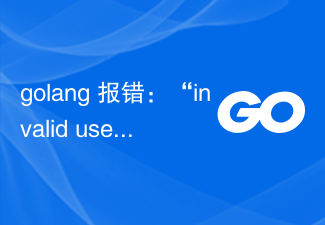 Backend Development
Backend Development Golang
Golang Common means to quickly diagnose and solve Go language website access speed problems
Common means to quickly diagnose and solve Go language website access speed problemsCommon means to quickly diagnose and solve Go language website access speed problems
Abstract:
With the popularity of the Internet, website access speed is crucial to user experience. This article introduces common methods to quickly diagnose and solve Go language website access speed problems, and provides relevant code examples.
Introduction:
Go language is a high-performance programming language commonly used to build websites and services. However, websites built using Go language may encounter some problems in terms of access speed. This article will introduce some common methods to help developers quickly diagnose and solve Go language website access speed problems.
1. Check the network delay
The access speed of the website is mainly affected by the network delay. Developers can use the ping command to check network latency with the server. For example, enter the following command at the command line:
$ ping example.com
This command will display the network delay with the example.com server. If the latency is high, developers should check whether the network connection is normal and contact the network service provider to resolve the issue.
2. Optimize database query
Database query is usually an important factor in slow website access. Developers can optimize database queries through the following methods:
1. Use indexes: Proper use of indexes can speed up database queries. In the Go language, you can use an ORM (Object Relational Mapping) library such as GORM to manage database operations, and specify the indexes that need to be used in the query through the GORM API.
2. Reduce the number of queries: merge multiple query requests as much as possible to reduce the number of interactions with the database. For example, you can use the JOIN statement in Go language to merge multiple query requests.
3. Cache query results: For some frequently accessed database queries, the query results can be cached in memory to reduce the number of database accesses. You can use caching libraries in the Go language such as Redigo or Go-Redis to cache query results.
3. Use parallel processing
The Go language inherently supports concurrent processing, and can speed up the response speed of the website through parallel processing. The following are some common examples of using parallel processing:
1. Using goroutine: In the Go language, goroutine is a lightweight thread that can be used to execute tasks concurrently. Developers can execute time-consuming tasks in a goroutine without blocking the processing of other requests. Refer to the following sample code:
func handleRequest(w http.ResponseWriter, r *http.Request) {
go func() {
// 耗时的任务
}()
// 快速响应请求
}2. Use channels for concurrent processing: Developers can use channels to communicate data between multiple goroutines. The following is a sample code that uses channels for concurrent processing:
func handleRequest(w http.ResponseWriter, r *http.Request) {
dataCh := make(chan string)
go func() {
// 耗时的任务
dataCh <- result
}()
result := <-dataCh
// 处理结果
} 4. Use caching
Using caching can greatly improve the response speed of the website. In the Go language, you can use some caching libraries such as go-cache or bigcache to implement the caching mechanism. The following is a sample code for caching using the go-cache library:
func handleRequest(w http.ResponseWriter, r *http.Request) {
cacheKey := "some-cache-key"
cacheData, found := cache.Get(cacheKey)
if found {
// 使用缓存数据
} else {
// 获取源数据
cache.Set(cacheKey, data, time.Duration(1)*time.Hour)
}
}5. Using CDN (Content Distribution Network)
CDN is a technology that caches static resources of a website in globally distributed nodes , which can speed up website access speed. Developers can use some CDN service providers such as Alibaba Cloud CDN or Tencent Cloud CDN to speed up access to Go language websites. After configuring the CDN, user requests will be redirected to the nearest CDN node, reducing network latency and data transmission time.
Conclusion:
This article introduces common methods to quickly diagnose and solve Go language website access speed problems, and provides relevant code examples. By identifying network delays, optimizing database queries, using parallel processing, using caching, and using CDN, developers can effectively improve website access speed and user experience.
The above is the detailed content of Common means to quickly diagnose and solve Go language website access speed problems. For more information, please follow other related articles on the PHP Chinese website!
 golang 报错:“undeclared name…” 如何解决?Jun 24, 2023 pm 03:31 PM
golang 报错:“undeclared name…” 如何解决?Jun 24, 2023 pm 03:31 PMGolang(Go编程语言)是一种基于C语言的编程语言,被广泛用于Web开发、网络编程、操作系统等领域。然而,在编写Golang程序时经常会遇到一个常见的问题,就是“undeclaredname”(未声明名称)错误。下面将介绍如何解决这个问题。了解错误信息在编译和运行Golang程序时,如果遇到了未声明名称错误,会在控制台输出相应的错误信
 PHP 500错误全面指南:原因、诊断和修复Mar 22, 2024 pm 12:45 PM
PHP 500错误全面指南:原因、诊断和修复Mar 22, 2024 pm 12:45 PMPHP500错误全面指南:原因、诊断和修复在PHP开发过程中,我们经常会遇到HTTP状态码为500的错误。这种错误通常被称为"500InternalServerError",它是指在服务器端处理请求时发生了一些未知的错误。在本文中,我们将探讨PHP500错误的常见原因、诊断方法以及修复方法,并提供具体的代码示例供参考。1.500错误的常见原因1.
 Java中的ClassNotFoundException——找不到类要怎么解决?Jun 25, 2023 am 08:30 AM
Java中的ClassNotFoundException——找不到类要怎么解决?Jun 25, 2023 am 08:30 AMJava中的ClassNotFoundException是一种常见的编译错误。当我们尝试使用Java虚拟机(JVM)加载某个类时,如果JVM找不到该类,就会抛出ClassNotFoundException。这个错误可能出现在程序运行时,也可能出现在编译时。在本文中,我们将讨论什么是ClassNotFoundException,它为什么会发生以及如何解决它。C
 golang 编译错误:"undefined: json.Marshal" 如何解决?Jun 24, 2023 pm 03:24 PM
golang 编译错误:"undefined: json.Marshal" 如何解决?Jun 24, 2023 pm 03:24 PMGo语言是一门越来越受欢迎的编程语言,它的简洁、高效、易于编写的特点已经被越来越多的开发者所认可。而在Go语言开发中,遇到编译错误是不可避免的。其中一个常见的错误就是“undefined:json.Marshal”。这个错误通常发生在你使用了Go标准库的“encoding/json”包时,编译器提示找不到“json.Marshal”的定义。这个问题的根本原
 Java错误:JDBC错误,如何解决和避免Jun 24, 2023 pm 02:40 PM
Java错误:JDBC错误,如何解决和避免Jun 24, 2023 pm 02:40 PM随着Java的广泛应用,Java程序在连接数据库时经常会出现JDBC错误。JDBC(JavaDatabaseConnectivity)是Java中用于连接数据库的编程接口,因此,JDBC错误是在Java程序与数据库交互时遇到的一种错误。下面将介绍一些最常见的JDBC错误及如何解决和避免它们。ClassNotFoundException这是最常见的JDBC
 golang 报错:“undefined variable or function” 如何解决?Jun 24, 2023 pm 05:18 PM
golang 报错:“undefined variable or function” 如何解决?Jun 24, 2023 pm 05:18 PMGo语言作为一门快速发展的编程语言,被广泛应用于各种项目和领域。然而,在使用golang编写程序时,你有可能会遇到一些报错,其中一个常见的报错是“undefinedvariableorfunction”。那么,这个错误是什么意思?它是如何产生的?又该如何解决呢?本文将会对这些问题进行探讨。首先,我们需要了解一些基本概念。在golang中,变量和函数是两
 golang 报错:“invalid use of , operator” 如何解决?Jun 24, 2023 pm 07:15 PM
golang 报错:“invalid use of , operator” 如何解决?Jun 24, 2023 pm 07:15 PM近年来,Golang一直受到越来越多开发者的青睐。但是,即使是最有经验的开发人员也会遇到一些挫折,比如一些报错。其中,一种常见的报错是:“invaliduseof,operator”。在这篇文章中,我将为大家介绍这个报错的原因,以及解决方法。首先,我们需要了解什么是","操作符。在Golang中,","操作符通常被用来在数组、参数列表或结构体中分隔不
 在Vue应用中遇到“SyntaxError: Unexpected token”怎么解决?Jun 24, 2023 pm 06:55 PM
在Vue应用中遇到“SyntaxError: Unexpected token”怎么解决?Jun 24, 2023 pm 06:55 PM在Vue应用中遇到“SyntaxError:Unexpectedtoken”怎么解决?Vue是前端开发中广泛使用的一个JavaScript框架,它可以让我们更轻松地管理页面的状态、渲染和交互。但是在编写Vue应用时,有时会遇到“SyntaxError:Unexpectedtoken”报错,这个错误提示意味着代码中存在语法错误,JavaScript引擎


Hot AI Tools

Undresser.AI Undress
AI-powered app for creating realistic nude photos

AI Clothes Remover
Online AI tool for removing clothes from photos.

Undress AI Tool
Undress images for free

Clothoff.io
AI clothes remover

AI Hentai Generator
Generate AI Hentai for free.

Hot Article

Hot Tools

MantisBT
Mantis is an easy-to-deploy web-based defect tracking tool designed to aid in product defect tracking. It requires PHP, MySQL and a web server. Check out our demo and hosting services.

Atom editor mac version download
The most popular open source editor

Dreamweaver Mac version
Visual web development tools

Notepad++7.3.1
Easy-to-use and free code editor

SublimeText3 English version
Recommended: Win version, supports code prompts!





